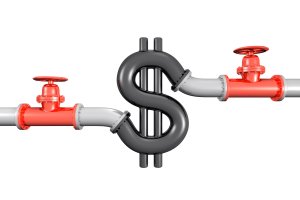Loan Pipeline: What Are They and What Purpose Do They Serve?

A mortgage loan pipeline allows loan officers to maximize their efficiency and increase their revenue. Understanding how these pipelines work can be the key that unlocks your true business potential.
What is a loan pipeline? How does it work? This guide will introduce you to the basics of mortgage loan pipelines and how they can enhance the lending process.
What Is a Loan Pipeline?
A mortgage loan pipeline is a set of loans that have been initiated but not completed. In some cases, the loans have been offered to potential homebuyers, though the sales have not yet closed.
The concept is simple. Loan officers initiate loans and secure a particular rate. They can then connect these loans to prospective homebuyers. The advantage is that the pipeline ensures that the interest rates and loan terms stay locked in. For the initial lender, this creates some risk, but it helps loan officers and borrowers land favorable loan terms.
How Does a Loan Pipeline Work?
To understand how a loan pipeline works, it’s important to distinguish between primary and secondary mortgage markets.
When a borrower receives a loan directly from a lender, they are operating within the primary market. But that doesn’t prevent them from selling that loan on the secondary market.
So a mortgage pipeline allows brokers to buy loans from an originator and then sell them to clients on the secondary market.
For Lenders
Lenders love this setup because it means they don’t have to worry about running low on money to lend. Instead, lenders can create loans and then sell them via the secondary market. This, in turn, frees up additional spending power.
Still, lenders have to be careful to maintain a balance between available cash and pending loans. Additionally, fluctuations in interest rates may prompt lenders to adjust the number of loans they produce.
The loan pipeline will determine how many more loans a lender can issue before the loans in the pipeline have been funded, closed, or sold.
For Brokers
For mortgage brokers, the mortgage pipeline is their primary source of income. Brokers and loan officers earn money based on the commission from the sale of mortgage loans. This ensures that loan officers work hard to connect clients to the right loans.
For Borrowers
Borrowers can often secure favorable rates when purchasing a home loan on the secondary market. But that doesn’t mean that borrowers won’t still experience snags.
Changes in the lender’s loan pipeline can delay the closing of a loan. This is why loan officers must work to ensure transparency and accuracy to avoid further delays in the lending process.
Example of a Loan Pipeline

Imagine that a borrower (or brokerage firm) initiates a loan. The lender offers a mortgage with a flat 5% annual percentage rate (APR). This interest rate will remain locked in for a predetermined period, or simply until the loan is sold on the secondary market.
At this point, the loan is neither completed nor funded. But the originator must adhere to the original loan terms. The task of the loan officer is to sell this loan to a prospective homebuyer.
You may have noticed that this introduces some risk. Sure, if interest rates fall, the lender can benefit from the higher interest rate. But if interest rates rise, then the lender will take the hit from having a low-interest loan in the pipeline.
Again, this is why lenders must monitor their pipeline carefully and adopt hedging strategies to offset this risk. The state of the market can determine whether a lender creates further loans, seeking to balance profits and losses as interest rates fluctuate.
Of course, in the real world, a loan pipeline would be populated by more than just this simple example. Lenders and brokers alike rely on a dynamic system to keep money moving and provide the right loans to the right clients.
What Purpose Does a Loan Pipeline Serve?
On paper, this process might seem needlessly complex. But a mortgage loan pipeline plays a valuable role in the mortgage and real estate industry. Here are just some of the ways a mortgage loan pipeline keeps the industry moving.
Keeps Costs Low for Borrowers
A loan pipeline can lock in a low rate for prospective borrowers. When lenders are able to offer loans through a broker, it creates greater competition. Borrowers will have an easier time securing low-interest rates and favorable loan terms.
Increases Liquidity
A mortgage loan pipeline keeps money moving. Not only is there greater liquidity but money moves faster thanks to a mortgage loan pipeline. And when money flows freely, the entire lending process flows efficiently as well. Without a pipeline, the entire system could come to a grinding halt.
Expands Borrower Opportunities
With more money moving, lenders are able to increase the number of lending opportunities available for borrowers. Basically, there’s just more money available. This means that lenders will be more likely to extend loans to a wider selection of borrowers.
Without a pipeline, borrowers would have to meet rigid standards in order to qualify. The pipeline allows more borrowers to gain access to the funding they need to finance their dream home.
Increases the Feasibility of Certain Loan Terms

A mortgage loan pipeline can make certain loan terms more feasible. It’s not that 15- or 30-year terms wouldn’t exist without the pipeline. But the pipeline keeps loan terms and interest rates more consistent across the board.
Borrowers with similar credit histories can expect similar loan terms and interest rates and can compare rates across lenders to find their best option.
Increases the Number of Loan Types
The loan pipeline can also increase the number of loan types available. When lenders are able to offer more loans, borrowers will have greater access to various loan types. For example, lenders can offer standard mortgages alongside other loan programs, such as options for refinancing.
How to Build Your Loan Pipeline
Building a loan pipeline can increase your bandwidth and enhance the services you offer your clients. But how do you do it? You can build your loan pipeline through several strategies, including the following.
Networking
Like any industry, mortgage lending relies on the right relationships. Consider networking with other professionals, such as
- Lending institutions
- Real estate agents
- Divorce attorneys
- Construction companies and contractors
These relationships tend to overlap and reinforce one another, helping you generate leads as well as helping you connect your clients to the appropriate loan programs.
Marketing
It’s important to get the word out about your lending business. Many customer relationship management (CRM) platforms include marketing tools that help you.
- Build a website
- Manage your email marketing campaigns
- Manage your social media platform
- Request customer feedback
In fact, the right tools can serve almost as an extra set of hands at your workplace and make it easier to build and manage your online reputation.
Relying on the Right Tools

Marketing tools are only the start of what you can do. Many of today’s tools can also help you with things like
- Data management/document storage
- Communication
- Integrating and automating core processes
The more efficient you are at processing loans, the more successful you’ll be as a loan officer. The right tools can make all of the difference.
What Is the Benefit of Loan Pipeline Management Software?
Many loan officers rely on loan pipeline management software to stay organized and automate certain aspects of the loan process. This can increase your efficiency dramatically, which is good for both you and the customers.
Loan pipeline management software offers benefits that include:
Greater Efficiency
Keeping your data in a centralized location can make you more efficient. You’ll be able to process loans faster, lowering your turnaround times. Additionally, automating your core processes allows you to have more time to focus on your clients.
Electronic signature options can even eliminate the need for face-to-face meetings with your clients. This likewise streamlines the lending process.
Greater Accuracy
When you rely on automated tools, you’ll minimize the errors that creep in from manual data entry. Additionally, many automated programs can perform a credit check and other essential processes.
Accurate information ensures that you connect borrowers with the right loan program as well as help them obtain a loan with favorable terms and rates.
Scalability
A software system enables you to expand your business. For starters, you’ll be better equipped to collaborate and share data between team members. But an integrated software platform also allows you to diversify your loans. As you grow, you can explore new territories and serve a greater array of clients.
Build Your Loan Pipeline Today
The best way to start building a loan pipeline is with the BNTouch platform. Our innovative CRM system allows you to integrate, automate, and streamline your core processes. Users can use our centralized software for marketing, communication, and much more.
To see these features in action, request a demo today. These tools will help you build your loan pipeline and serve your clients like never before.
The post Loan Pipeline: What Are They and What Purpose Do They Serve? appeared first on .



